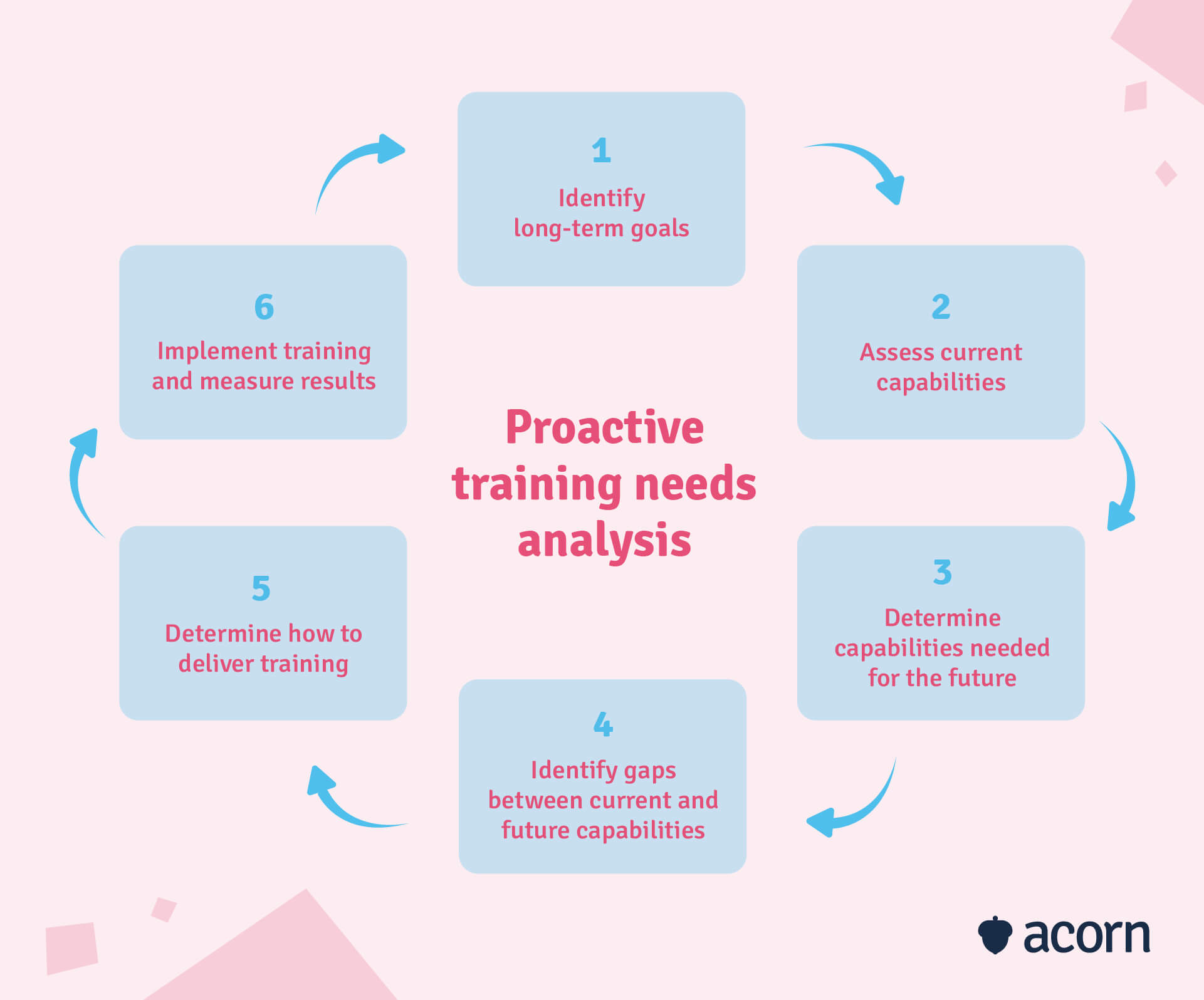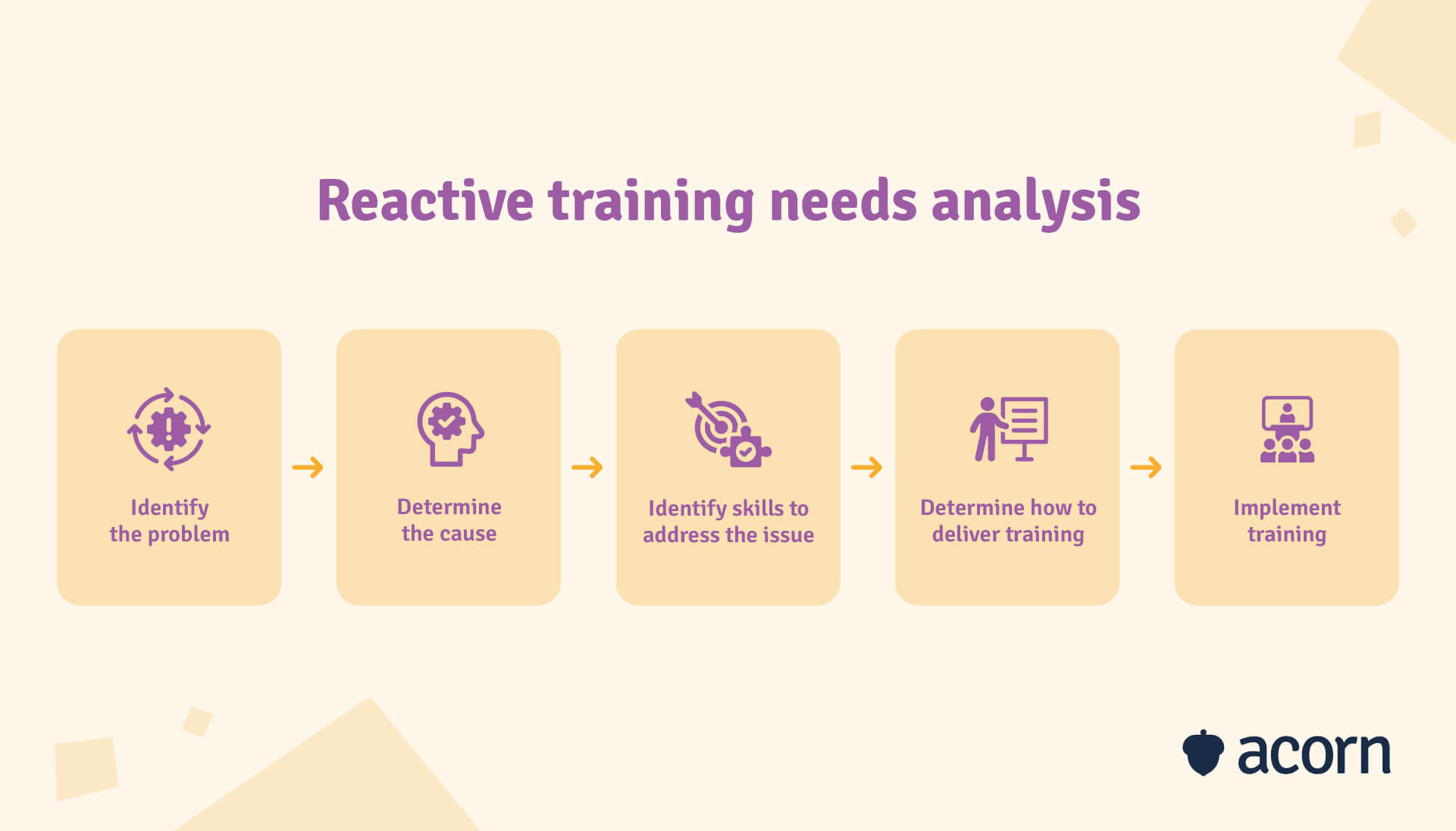How to Use a Training Needs Analysis to Determine Training Effectiveness
Reading Time:

Lead the pack with the latest in strategic L&D every month— straight to your inbox.
SubscribeSearching for gaps in your organisation’s current capabilities that will deliver on goals?
You need a training needs analysis. Its whole schtick is finding training pain points and building an effective training program to address them.
In this article we’ll get into how you can use a training needs assessment to identify and meet training goals to achieve your company’s desired outcome.
What is a training needs analysis?
A training needs analysis (TNA) is a process used to identify the skills, knowledge, and abilities required to perform a job effectively and compare them to current capabilities. It’s a key tool for identifying training needs and determining the most effective way to bridge capability gaps through training.
The benefits of a training needs analysis
If you want to improve the performance of your business, a training needs analysis is a good place to start. Without further ado, we’ll jump into the positive business impacts of a TNA.
- Improved performance: In 2018, Gartner found that up to 80% of employees didn’t have the skills they needed to complete their current or future roles. And, again in 2021, 58% of the workforce still didn’t have the skills required to do their jobs. Identifying specific training needs of your employees allows you to create targeted, tailored training with the goal of closing performance gaps, in turn giving your employees the ability to work more efficiently, productively, and deliver on performance goals.
- Increased ROI: Your ROI is the monetary value gained for each dollar spent on learning programs as a result of effective training driving increased performance. It also helps in setting L&D budgets, as you’ll have evidence of training effectiveness at a reasonable cost.
- Increased staff retention: 94% of employees say they’re more likely to stay with a company for longer if the company takes the time to invest in their professional development. What’s more, providing employee training means that employees feel 47% less stressed at work, increasing employee satisfaction and reducing turnover even more.
- Legal compliance: Perhaps your industry requires all staff to keep up to date on the latest certifications, licences, or technical capabilities. Not keeping on top of these can lead to legal ramifications, or even the inability of your business to continue to function due to non-compliance. A TNA can identify areas where an organisation needs to be in compliance with specific laws and regulations pertaining to your industry.
So, what does this mean for L&D professionals?
The big one: It shows where your employees might have a skills gap that should be plugged to benefit them in their current and future roles.
This leads to prioritising training efforts. You can use the information gleaned from a TNA to identify areas where employees need the most help, allowing you to focus efforts on the training that will have the greatest impact on employee performance and your organisation’s bottom line. Prioritising becomes easier to do because TNAs help with aligning your training with your organisational strategy.
It can also assist in evaluating training effectiveness. By assessing the capabilities your employees possess both before and after training, you’ll get an idea of how well your employees have retained the required knowledge and skills for their roles.
Perhaps most important to L&D in an organisation is how it can justify and increase value of spend, positioning L&D as the ultimate business partner in driving business strategy and organisational transformation for the future.
All this is possible with a performance learning management system (PLMS), which we’ve pioneered here at Acorn. It’s a dynamic AI-powered tool for synchronising L&D experiences with business performance, designed to codify and operationalise capabilities to drive organisational efficiency. A PLMS curates internal and third-party sources to serve up the right learning recipe for each person’s betterment (and for the betterment of the business, as well).
Proactive vs reactive training needs analysis
There are two types of training needs analysis.
A proactive training needs analysis is conducted as part of a long-term strategy to anticipate the capabilities that employees will need in the future and identify the training required to ensure they have those capabilities when needed.
A reactive training needs analysis focuses on immediate needs in response to a specific event or problem rather than a long-term training and development plan. For example, if you’re experiencing a specific performance issue or problem that has arisen in the workplace such as low productivity or high rates of error, a reactive training needs analysis can help identify the specific training needed to address the issue.
Conducting a proactive training needs analysis

There are six basic steps to carrying out a proactive training needs analysis, but you should tailor, tailor, tailor to create a process that fits your organisation’s specific training needs. This TNA type needs to be carried out regularly to ensure your business is keeping ahead of the competition.
- Identify the long-term goals and objectives of the organisation. You aren’t just identifying a problem at hand–now you’re looking at what you want your organisation to achieve in the future. Working this out ensures that the training you develop aligns with the overall direction and strategic priorities of your organisation.
- Assess the current skills and knowledge of the workforce. This might involve conducting employee surveys, focus groups, or interviews to gather information about the skills and knowledge that employees currently possess.
- Determine the skills and knowledge that will be needed in the future. Consider the changing needs of the organisation, technological advancements, and other factors that may impact the skills required by your business in the next few years in line with your desired outcomes.
- Identify the gaps between the current and future capabilities of your workforce with a gap analysis. Understanding the disparity between them helps you prioritise and set the right training to bridge your skills gap.
- Determine the most effective way to provide training. This may involve selecting a specific training program or developing a customised training solution (like an LMS). Just ensure it’s relevant to your specific needs
- Implement the training. This may involve scheduling the training, preparing materials and resources, and delivering the training to the employees who need it. And, because TNAs are an ongoing process, it’s important to measure results as well as gather training feedback to ensure continuing transformation for your business.
Conducting a reactive training needs analysis

Again, this type of TNA is usually in reaction to an unforeseen or unexpected problem that’s arisen in your organisation, so it’s usually conducted as a one-off.
- Identify the problem. This could be a performance issue, a change in regulations or policies, or some other issue that has arisen in the workplace. Let’s say your business isn’t performing as well in sales as you expected.
- Determine the root cause. Once the problem or issue has been identified, the next step is to determine the root cause of the problem. This will involve gathering data and information about the issue and analysing it to determine the underlying causes. So, if your business isn’t getting the sales it wanted, what’s the cause? Maybe your sales team isn’t closing enough deals, or your marketing isn’t reaching enough people.
- Identify the skills and knowledge needed to address it. Consult with the relevant stakeholders here. These will be subject matter experts, current employees and managers who have experience with the issue and the knowledge required to fix it. You should also review relevant documents and materials. If the cause of your sales issue is with a lack of marketing, your marketing team may need training in new skills and methods of disseminating advertising.
- Determine how you’ll provide training. This involves selecting a specific training program or developing a customised training solution. For example, an online course might help a marketing team build skills in new marketing methods, but if your solution is to provide a new tool or program for marketing to employ, then it might be more helpful for them to practice with it hands-on.
- Implement training. This is scheduling the training, preparing materials and resources, and delivering it to the employees who need it. But remember to communicate the need for training to participants to maximise buy-in and learning engagement. You can’t just dump a new tool at the feet of your marketing team and expect them to start training in it. You need to ensure they know what learning about the tool’s features entails for their ability to perform their job role.
The challenges of conducting a training needs analysis
Of course, conducting a TNA isn’t always easy. While you might come across some challenges in the process of doing a TNA, they aren’t difficult to overcome. The main barriers you might face are:
- Lack of buy-in from employees and managers alike. We’ll say it: Not everyone is keen to participate in training activities. This is called organisational resistance to change. But, if you foster a culture of learning in your workplace, employees will be more open to taking up training when the opportunity arises.
- Lack of new information and data. Finding new, accurate data on the root cause of the problem might be difficult, especially when you’re using a reactive TNA. This leads to an inability to actually address the real issue. To avoid this, you should make a point of gathering data on your current capabilities regularly. This way, you don’t end up scrambling to find all the information at once, and instead have up-to-date data to reference from the get-go.
What are the risks of not doing a training needs analysis at all?
Regardless of challenges, there are risks if you skip a training needs analysis altogether.
Let’s start with an inability to identify knowledge and performance gaps. LinkedIn’s 2022 Workforce Learning Report found that 46% of L&D professionals noted a widening skills gap in their organisations, an increase of four points from the previous year. The longer a gap like that goes unaddressed (or even undetected), the harder it is to close in the long run.
Yet, without a TNA to highlight said gap between current and future capability needs, you aren’t going to be able to tailor training appropriately. That means not only will your employees be falling behind in their individual capability development, but your business will trail behind competition and be unable to meet strategic priorities. At the other end of the spectrum, you may end up providing training that is neither relevant nor necessary, wasting time, resources and the willingness of your employees to engage with L&D. In this case, it’s very likely that your learning outcomes won’t hit the mark either.
And when employees feel they aren’t receiving the support and development they need to succeed and grow in their roles, job satisfaction decreases and turnover increases. While 94% of employees are more likely to stay with an organisation if offered training opportunities, many are 50% more likely to look for employment elsewhere without support from managers and ten times more likely to look for a new job if they felt their skills weren’t being put to good use. In short? You don’t have a solid basis for an EVP without a training needs analysis.
Key takeaways
A training needs analysis is a key tool in capability building, comparing the current capabilities of your employees to the capabilities required for them to perform their job effectively. While both reactive and proactive training needs analyses do the same thing, a proactive TNA also anticipates the future needs of your business, allowing you to be agile and competitive in the face of industry change.